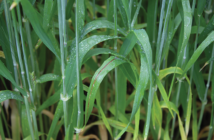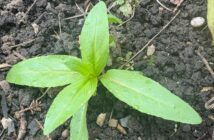Growers planning this season’s winter wheat disease control should keep crops in a preventive situation, rather than risk diseases getting a foothold, given reduced curative activity of triazole fungicides against Septoria tritici and the speed with which rust can flare up, say agronomy experts.
From a practical viewpoint, this includes using correct spray timings so that fungicide intervals aren’t stretched too far, and putting emphasis on a strong T1 to stop disease getting out of hand by T2, they add.
“Because we’ve now got so little curative activity with triazoles against Septoria tritici, it’s now much more important to get T1 right,” explains Simon Trenary, South West-based agronomist for leading agronomy firm, Hutchinsons. “If you don’t, and you get a vast amount of infection on leaf three, you’re going to struggle to keep the crop clean higher up in the canopy.”
Additionally, Mr Trenary says the T0 to T1 gap must be kept suitably tight: if T1 is typically applied around 20 April, a March-applied T0 is likely to have run out of steam before the T1 is applied, adding pressure to the T1 programme to eradicate established disease – and Septoria in particular.
Similarly, the T1 to T2 interval should not be stretched, he says, with T1 timed to coincide with leaf three emerged, rather than a numerical growth stage.
“Where the T1 is applied too early, programmes will run out of steam before the crop reaches the T2 timing. T1 programmes applied at leaf three fully emerged provide enough protection to keep the crop clean through until the flag leaf fungicide can be applied, in most cases. Where Septoria is your key target, it’s better to talk about leaf three emerged than growth stage 32.”
To boost activity at T1, Simon Trenary says there has been a shift to utilising new-generation SDHI chemistry at this key timing in high pressure seasons. Low disease pressure in 2013 meant he used conventional T1 chemistry, but with higher pressure last season, he says the majority of the winter wheat he looked after received an SDHI at T1.
“It was a good opportunity for crops to benefit from an SDHI,” he says. “For example, I used IZM with epoxiconazole where I had yellow rust in Gallant at T1 and the programme performed very well. It was in a yellow rust hotspot in Somerset, where you get added humidity from the sea and hills.
“This treatment at T1 compared favourably, cost-wise, with other SDHIs + pyraclostrobin. My only reservation was I thought it was going to be less active against Septoria tritici than other SDHIs, but that wasn’t the case. It kept the crop clean and I used IZM with epoxiconazole and chlorothalonil again at T2.”
This season, Mr Trenary says he is considering including an SDHI at T1 again. “If you’ve lost the Septoria tritici battle at T1, the level of protection of the flag leaf is likely to be compromised too – which will be reflected in reduced yields.” he adds.
In the East, Hutchinsons technical manager Dick Neale echoes Simon Trenary’s comments about timings and increased new-generation SDHI use at T1, but says yellow rust can typically be more of a driver for fungicide decisions than in the West.
“In the East, frequently we can control Septoria tritici very well,” says Mr Neale, “but we’ve got the complication of more frequent yellow rust outbreaks.
“That does tend to focus the mind with regard to timing. We have to be spot on for yellow rust, because it can cycle so quickly,” he adds.
Also in the East, Mr Neale says later drilling – either because of black-grass or after root crops – can reduce Septoria tritici pressure.
“We also have varieties that give us a bit more time on Septoria. But yellow rust can force us into these crops.
“I wouldn’t say use a blanket SDHI, but judge when it’s needed. If I’m using an SDHI mixed with an appropriate triazole and chlorothalonil at T1, I’m fairly relaxed with a four-week gap between T1 and T2.
“We’ve got a collection of good fungicides to choose from. IZM is long-lasting and is very good on rust and Septoria tritici. The key with both diseases is it must be applied to a largely disease-free canopy. More resistant varieties should be reasonably clean at T1.”
Syngenta campaign manager, Melanie Wardle, agrees with the importance of maintaining crops in a preventive situation and correct timings, and with the growth in SDHI use at T1.
“We see the long-lasting activity of IZM – which is contained in treatments such as Keystone – as a key feature for maintaining protection given current Septoria tritici and rust issues,” Mrs Wardle adds.



